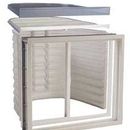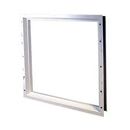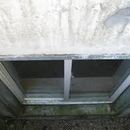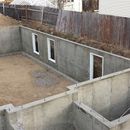Basement Window Thermal Bridge
The status quo installation method for basement windows in Denver is the cast in place steel window buck. Obviously, it’s a major thermal bridge problem.
I’ve decided to insulate the basement on the inside of the foundation walls.
Has anyone seen or developed an easy and effective method of insulating the inside of a window buck? Attached are of photos of what I have.
Do you think it would it be worth the effort to cut the steel buck itself (after the concrete is cured) in half at the window plane? It would take 10-15 minutes each and would use up one 4″ ($3.00) metal cutting blade.
GBA Detail Library
A collection of one thousand construction details organized by climate and house part













Replies
Kevin,
The answer to your question depends on your performance goals. If this is a Passivhaus, this type of thermal break is unacceptable. The best solution would be to make a window buck out of rigid foam, and to install the foam buck inside of the steel buck. Of course, this would make all of your windows and doors much smaller.
It's a little late in the process to be coming up with a solution to this problem. You may just have to compromise, and bring your interior wall foam as close as possible to the window, and call it a day.
If I'm understanding, the steel bucks are already cast in place, and you are suggesting making a cut around the inside perimeter (in the plane of the pane) with a cutting wheel? It's not quite the same, but I was recently looking at the insulation difference between standard double paned aluminum windows and "thermally improved" double paned aluminum windows. The "improved" look to have about a 3/16" - 1/4" plastic insulator breaking up the otherwise continuous aluminum frame in that same plane.
For a 2'x3' picture window, the total window U-value drops from about .4 to .3 by adding this break. Aluminum is a much better conductor than steel, but your steel is probably thicker, so seems fair to guess that the initial U-value would be roughly comparable for both materials (just the metal, not the whole installation). Your gap will be much thinner than 3/16", and it will also be well-bridged on one side by conductive concrete instead of moderately insulating wood.
This makes me think you won't gain a lot by cutting a thin break. Mentally, consider the ideal situation where instead of cutting a slit, you removed the entire frame/buck, and managed to mount the window directly against the concrete. You'd still have a lot of heat escaping around the edges through the concrete. So like Martin says, you'd probably be better off improving your insulation around the window rather than trying to reduce the heat conductance of the frame after the fact. Or perhaps adding a small amount of insulation to the exposed concrete on the external sill and surrounding.
ps. I haven't tried it, but if you want real numbers, the Therm software from LBL might be fun to model the difference with: http://windows.lbl.gov/software/therm/therm.html